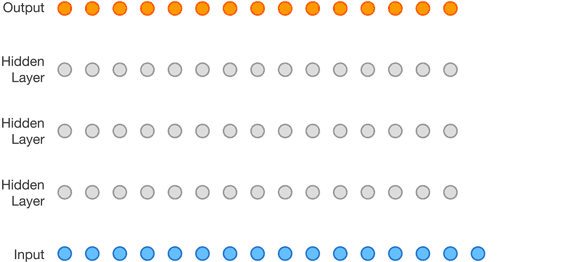- 感受野(Receptive Field)的定义:卷积神经网络的每一层输出的特征图上的像素点在原图像上映射的区域大小。[^ 1]
- 感受野计算公式:
-
$n=1$ 时,$r_1 = k_1$ -
$n \geq 2$ 时,$r_n = r_{n-1} + (k_n - 1) \cdot (\prod_{i=1}^{n-1}s)$ - 其中r表示receptive field,k表示kernel size,s表示stride。
-
- 以图为例:
-
$n=1$ 时,$r_1 = k_1 = 3$ -
$n=2$ 时,$r_2 = r_1 + (k_2 - 1)\cdot s_1 = 3 + (2 - 1) \cdot 2 = 5$
-
- 多层 CNN 的一个不足之处在于,由于池化层的存在,响应张量的大小(长和宽)越来越小,在一些任务比如用FCN做图像语义分割任务时,需要输入和输出的像素点一一对应,因此 FCN 做了上采样,将池化变小的层张量再变大。但是上采样并不能将丢失的信息全部无损地找回来。
- 对此,dilated convolution 是一种很好的解决方案——既然池化的下采样操作会带来信息损失,那么就把池化层去掉。但是池化层去掉随之带来的是网络各层的感受野(receptive field)变小,这样会降低整个模型的预测精度。Dilated convolution 的主要贡献就是,如何在去掉池化下采样操作的同时,而不降低网络的感受野。
- 以上图为例,三张图分别都是经过dilated conv后的第一、二、三层,由于没有池化,他们大小不变。每一次dilated conv时,卷积核大小不变,但是输入的张量则是隔了几个像素点取的。也可以看做是卷积核大小变了,但是卷积核中只有9个点有权重系数,其余点的权重系数都为0。[^ 2]
-
我自己猜的公式,暂时没有找到来源:
-
$n=1$ 时,$r_1 = k_1$ -
$n \geq 2$ 时,$r_n = r_{n-1} + (k_n - 1) \cdot (\prod_{i=1}^{n-1}s) \cdot d_{n}$ - 其中r表示receptive field,k表示kernel size,s表示stride,d表示dilate(一般在做dilated conv时,$d_n$会取$2^{n-1}$以形成类似binary tree的结构,见本文后面的动图)。
-
- 以图为例:
- 对应图a,$n=1$时:$r_1=k_1=3$
- 对应图b,$n=2$时:$r_2 = r_1 + (k_ 2- 1) \cdot s_1 \cdot d_1 = 3 + (3-1)\cdot 1 \cdot 2 = 7$
- 对应图c,$n=3$时:$r_3 = r_2 + (k_3 - 1) \cdot (s_1s_2) \cdot d_2 = 7 + (3-1)\cdot(1\cdot1)\cdot4 = 15$
- 该图的原论文给出的公式(符号改了一下使本文前后文统一)是$r_n=2^{n+1}-1$。[^ 3]
- 显然我上面总结的公式是递推式,在该图中,$k=3$,$s=1$,$d_{n}=2^{n-1}$(一般在做dilated conv时,$d_n$会取$2^{n-1}$以形成类似binary tree的结构,见本文后面的动图)
- 代入后可以得到:$r_n = r_{n-1} + (3 - 1) \cdot (\prod_{i=1}^{n-1}1) \cdot 2^{n-1}=r_{n-1} + 2^n$。
- 解该递推公式得:$r_n=2^{n+1} - 1$,一致。
- 本篇论文的笔记也可以参考[^ 4]
- RNN has potential drawback.
- serial structure prevents from being run in parallel.
- Forward and backward signals need traverse the full distance to learn the dependencies between tokens.
- A number of NMT models
- Encoder-decoder network, attentional pooling, 2-dimensional networks, etc
- Despite the generally good performance, they:
- have running time that is super-linear in the length of source/target sequences.
- process the src seq into a const size representation, burdening the model with a memorization step.
- ByteNet
- uses one-dimensional CNN of fixed depth for both the encoder and the decoder.
- The two CNNs use increasing factors of dilation to rapidly grow the receptive fields
- Desiderata
- First, the running time of the network should be linear in the length of the source and target strings.
- Second, the size of the source representation should be linear in the length of the source string, i.e. it should be resolution preserving, and not have constant size.
- Third, the path traversed by forward and backward signals in the network (between input and ouput tokens) should be short.
-
Encoder-Decoder Stacking
- 相比其他encode-decode网络的区别在于,不再仅仅通过一个定长的encode vector或者attention vector连接两个网络,而是将source network每一个输出都作为target vector对应位置上的输入。
- 有点像是dilate=1,2,4,8...后又来了一次dilate=1,2,4,8,...
- 但是输入和输出又不一样长,怎么直接Stack呢?
-
Dynamic Unfolding
- source length
$|s|$ , target length$|t|$ - sufficiently tight upper bound
$|\hat{t}|=a|s|+b$ - 德语句子一般比英语长,设a=1.2,b=0 (这些都不重要。。)

- 令encoder和decoder这两个一维卷积长度都为$|\hat{t}|$(随着不同source句子长度变化,不固定),source端不足的就补,而target端最终预测的长度不固定,以遇到EOS为准。
- 如果遇到EOS时的长度<$|\hat{t}|$, 则同时使用encoder的representations和decoder前面时刻的输出。
- 如果直到超出$|\hat{t}|$都没预测完,那就只使用decoder前面时刻的输出。
- source length
-
Masked One-dimensional Convolutions
- 就是保证decoder只和历史相关,不和未来相关。所以decoder在每一个输出时刻只有左边一半。
- dynamic unfolding是从左往右展开的,右边的不知道,显然没法用。
-
Dilation
-
Residual Blocks 残差网络
- Each layer is wrapped in a residual block that contains additional convolutional layers with filters of size 1 × 1
- Time代表时间复杂度,RP代表resolution preserving,Paths代表source网络从输入到输出的路径长度,Patht代表target网络从输入到输出的路径长度。Path越短代表反向传播的层数越少,网络越容易收敛,因为网络越浅越不容易出现梯度扩散。
- ByteNet可以用RNN,也可以用CNN来实现。本文是用CNN实现的,但是也分析了一下RNN的复杂度。
- 其实之前Seq2seq的模型也是线性复杂度的,ByteNet比它好在:
- Resolution preserving。不再是把encoder representations塞到一个固定长的向量中。
- Path变短,为常数$c=log d$,d是在翻译中需要走过的依赖长度。
- ByteNet比attention模型好在:
- 时间复杂度从平方复杂度变成了线性复杂度。
- Path变短为常数。
[^ 1]: 深度神经网络中的感受野(Receptive Field)
[^ 2]: 如何理解空洞卷积(dilated convolution)? - 知乎
[^ 3]: Yu, F., & Koltun, V. (2015). Multi-scale context aggregation by dilated convolutions. arXiv preprint arXiv:1511.07122.






